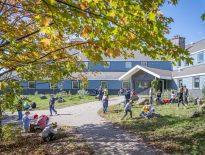Accelerating the Regenerative Materials Movement
A Path to a Better Future
Recently I wrapped my first Ecotone project with my ILFI colleagues Michael Berrisford and Juliet Grable and their editorial team, and I am delighted to introduce the new book, The Regenerative Materials Movement (Ecotone, 2023). These dispatches about regenerative materials are a primer on the issues at play in our work.
Using the three pillars of our work—climate, health, and justice—we sought to represent a variety of intersecting issues that all relate to the impacts that building materials have on our world. We acknowledge that there are more subjects and voices than we’ve assembled, but it is a powerful introduction to these topics and a instructive guide for practitioners and supporters that entices and encourages deeper examination.
This is great progress. We are beginning to know what we are building with enough to make better decisions about the impacts we want them to have.
The viewpoints are those of people who are in the very thick of it, including ILFI’s own Hannah Ray and Susan Puri as well as Robin Bass & Lauren Sparandara (Google), Dana Bourland (JPB Foundation), William Browning (Terrapin Green), Gina Ciganik (Healthy Building Network), T. Campbell, R. Temple, P. Vanderford, T. Seager (Sustainable Northwest Wood) Don Davies (carbon expert), Kelly Alvarez Doran & James Kitchin (MASS Design Group), Heather Henriksen (Harvard University), Kathleen Hetrick (Buro Happold), Jeff Hurley (Blue Green Alliance), Carol Kwiatkowski (Green Science Policy Institute), Malisa Maynard (Mohawk), Alison Mears & Jonsara Ruth (Healthy Materials Lab) Alex Muller (Mindful Materials), Sharon Prince (Grace Farms), Christina Rabb (Ph.D. in materials chemistry), Veena Singla (National Resources Defense Council), Rebecca Stamm (Healthy Building Network), Charley Stevenson (Integrated Eco Strategy), and Wendy Vittori (Health Product Declaration Collaborative).
No matter the scale of a project, decisions about materials that design teams and owners make occur in a vast, complex, unwieldy, and fraught landscape. For many years, teams have slogged along, sifting through unaligned and incomplete information, making the best decisions they could at each step of a project. Through the emergence of the transparency movement that the ILFI has helped to lead, we are seeing a huge influx of data and reporting activity: increasingly, product manufacturers are showing building professionals what is in their products. This is great progress. We are beginning to know what we are building with enough to understand and make better decisions about the impacts we want them to have.
Many organizations are working hard to make materials vetting as easy and simple as possible. ILFI is proud to be doing part of that work through our Declare Label program, our Living Product Challenge program, and through the facets of our work in the Living Building Challenge and elsewhere that promote awareness, best practices and advocacy around regenerative building materials. And we are also so happy to be doing this work in coalition with so many wonderful people and organizations around the world who are pushing for change alongside us.
When we say “regenerative,” we mean materials that are safe for our bodies and ecosystems, sequester carbon emissions from our atmosphere, create jobs that sustain families and communities, and enable local economies and communities to thrive.
As you will read in my own foreword to the book, there are three themes that emerge in these pages. The first that stood out to me is the deep, passionate agreement that this movement can only be successful through collaboration and interconnection. The second theme that struck me relates to the rapid emergence of voices, expertise, and power in the Global South. A final theme speaks to deep considerations of justice. Many of the contributors are keenly aware that historically, the modern environmental movement has not focused enough on the impacts of environmental and health injustices. Indeed, the authors illustrate how justice is fundamental and intersectional to the work.
Together, we are working to usher in a new era of building where the materials we use are regenerative. When we say “regenerative,” we mean materials that are safe for our bodies and ecosystems, and which sequester carbon emissions from our atmosphere, create jobs that sustain families and communities, and enable local economies and communities to thrive. We hope this book supports you and your team on the path ahead.


